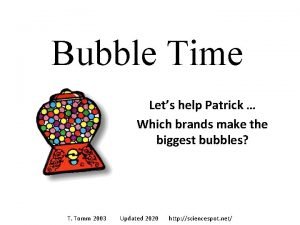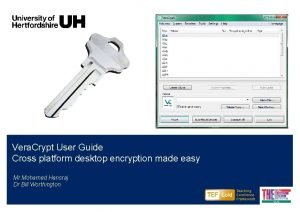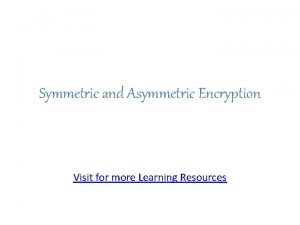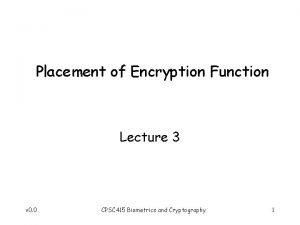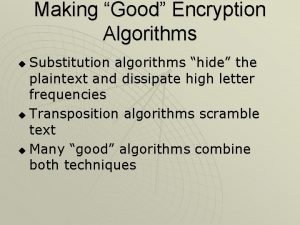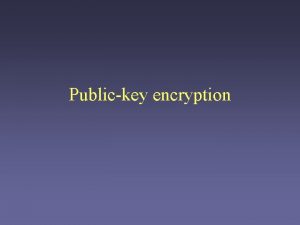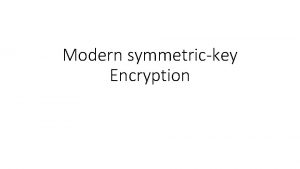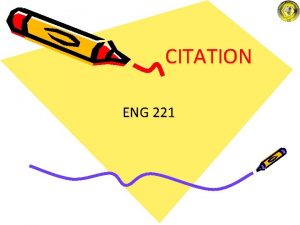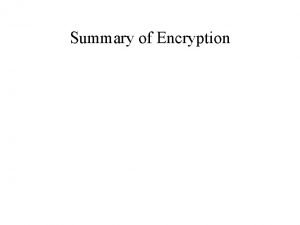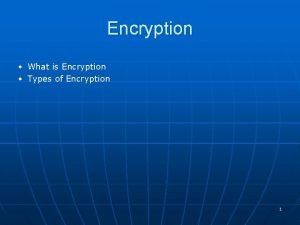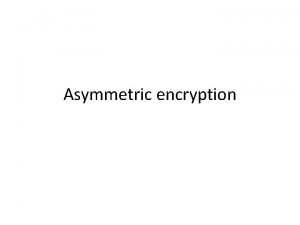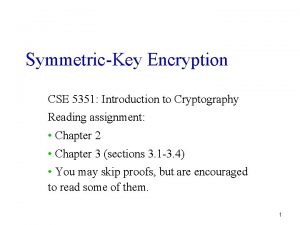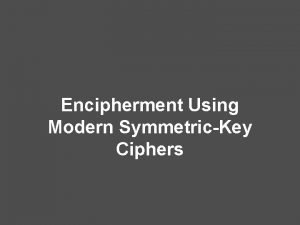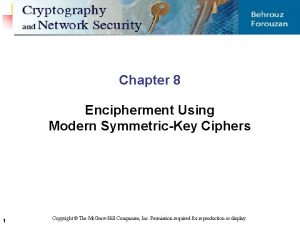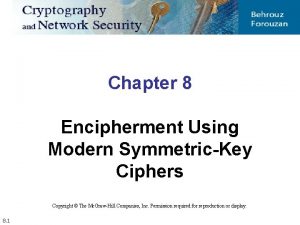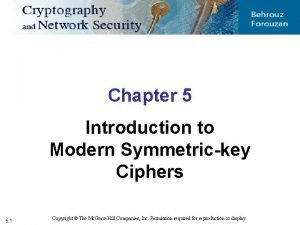Modern symmetrickey Encryption Citation I would like to































- Slides: 31

Modern symmetric-key Encryption

Citation • I would like to thank Claude Crepeau for allowing me to use his slide from his crypto course to mount my course. Some of these slides are taken directly from his course. • Comp 547 at Mcgill university

Overview of sec • The Concrete Approach • The Asymptotic Approach • Defining Computationally-Secure Encryption • The Basic Definition of Security • Constructing Secure Encryption Schemes • Pseudorandom Generators • Proofs by Reduction • Fixed-Length Encryption Scheme • Stronger Security Notions • Security for Multiple Encryptions • Chosen-Plaintext Attacks and CPA-Security

Computational Security • What does it mean to be pseudo-random • Things can look random when they are not • This can be used to achieve secure encryption while using short keys

Computational Security • Encrypt many messages using short keys • Limitations of perfect secrecy can be bypassed • We can achieve a strong but necessarily weaker notion than perfect secrecy

Computational approach to secure encryption • A computation encryption scheme can be broken given enough time • Try all the keys until you find the right one • Guess keys until you find the right one • Under certain assumptions, it should take millions of years to break an encryption scheme even given all the (current and future) computation power available on earth

Weakening of security • The computational approach incorporates two relaxations of the notion of perfect security • Security is only preserved against efficient adversaries that run in a feasible amount of time • Adversaries can potentially succeed with some very small probability.

Concrete security • The concrete approach quantifies the security of a cryptographic scheme by bounding the maximum success probability of any adversary running for at most some fixed amount of time. • That is, let t, ε be positive constants with ε ≤ 1. A scheme is (t, ε)-secure if every adversary running for time at most t succeeds in breaking the scheme with probability at most ε.

Concrete security •

Asymptotic security •

Algorithm running time and success probability. •

Negligible function •

Security • A scheme is secure if: Every Probabilistic Polynomial Time Adversary (viewed as an algorithm) succeeds in breaking the scheme with only negligible probability.

Warning •

Secure encryption scheme (in terms of game)

Encryption game c b c c guess

Encryption game c c An encryption scheme is secure if a distinguisher cannot guess which of these two games he is playing with more than one-half plus negligible probability

Computational indistinguishability •

Definition of Pseudo-random generator • w

Definition of Pseudo-random generator • w w

Encrypting a message from a short key using a pseudo-random generator

CPA-secure c Repeat as many times as the adversary wants b

Chosen-plaintext security c m c Repeat as many times as the distinguisher wants

Midway islands (non-CPA secure) • American cryptanalysts thought: * = Midway Island • Americans sent: “Midway is low on water” • Japanese sent: “* blah” • Americans confirmed that * = Midway Island • Lesson: Adversaries can influence the message.

On the (in)security of deterministic encryption scheme • An encryption scheme is deterministic Each plaintext maps to a unique ciphertext • Can deterministic encryption scheme be CPA-secure? No! Encrypting the same plaintext twice results in the same ciphertext. • Lesson: Secure encryption requires randomness

Definition of random function • Consistency: if you query a random function with the same input, it will give you the same output • Random: If you provide a new input to a random function, it will give you a random output

Pseudo-random function Repeat as many times as the distinguisher wants

Pseudo-random function • m m Repeat as many times as the distinguisher wants

CPA-secure encryption scheme from PRF •

Building a distinguisher for the PRF using a distinguisher for the encryption scheme guess

Building a distinguisher for the PRF using a distinguisher for the encryption scheme guess
 Would rather contraction
Would rather contraction Would prefer would rather
Would prefer would rather Date apa format
Date apa format If past perfect
If past perfect Expressing preference would rather
Expressing preference would rather I would like to choose
I would like to choose Paired conjunctions
Paired conjunctions Oraciones con would like
Oraciones con would like Banana plural nouns
Banana plural nouns Satisfactory moral theory
Satisfactory moral theory I like bananas in french
I like bananas in french Do you like bananas
Do you like bananas I would like to acknowledge the traditional
I would like to acknowledge the traditional Would you like to be a journalist
Would you like to be a journalist What are these people saying?
What are these people saying? Would you like banana or strawberries
Would you like banana or strawberries Would you like some chicken
Would you like some chicken Would like
Would like Would you like some noodles
Would you like some noodles Treat others the way you would like to be
Treat others the way you would like to be I would like to say something please
I would like to say something please Would you like some soup
Would you like some soup Patrick loves bubblegum and would like
Patrick loves bubblegum and would like Simon would like ___ basketball.
Simon would like ___ basketball. Your uncle would like to restrict his interest rate risk
Your uncle would like to restrict his interest rate risk I would like to thank my supervisor
I would like to thank my supervisor Vera crypt
Vera crypt Homomorphic encryption standard
Homomorphic encryption standard Disadvantages of asymmetric encryption
Disadvantages of asymmetric encryption Explain about the placement of encryption function.
Explain about the placement of encryption function. Exchange hosted encryption
Exchange hosted encryption Making good encryption algorithms
Making good encryption algorithms






















